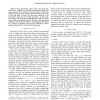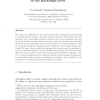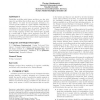82 search results - page 6 / 17 » Product Rules in Semidefinite Programming |
FUZZIEEE
2007
IEEE
14 years 2 months ago
2007
IEEE
— Fuzzy Description Logics (fuzzy DLs) have been proposed as a language to describe structured knowledge with vague concepts. It is well known that the choice of the fuzzy operat...
COGSR
2011
13 years 2 months ago
2011
We present an application of the analytical inductive programming system Igor to learning sets of recursive rules from positive experience. We propose that this approach can be us...
ICPADS
1996
IEEE
13 years 11 months ago
1996
IEEE
A new multiagent programmingparadigm based on the transactional logic model' is developed. This paradigm enables us to construct a Distributed agent transactional program (DA...
MODELS
2009
Springer
14 years 2 months ago
2009
Springer
Variability modelling with feature models is one key technique for specifying the problem space of software product lines (SPLs). To allow for the automatic derivation of a concre...
VL
1998
IEEE
13 years 12 months ago
1998
IEEE
This article presents the animated visual 3D programming language SAM (Solid Agents in Motion) for parallel systems specification and animation. A SAM program is a set of interact...



